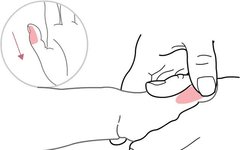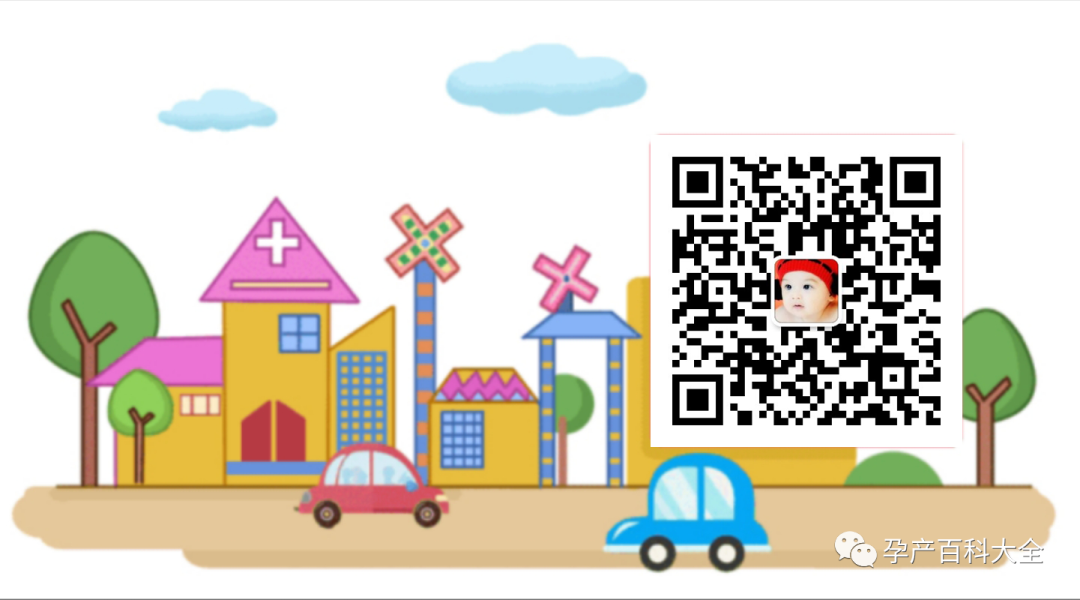


Tuina for children is a method that combines both regulation and treatment, and when applied correctly, it can yield excellent results. However, like any method, it has its applicable scope, and pediatric tuina is no exception. Its indications include common and frequently occurring diseases of the pediatric digestive and respiratory systems, such as colds, coughs, diarrhea, vomiting, indigestion, and malnutrition, as well as common symptoms like night crying and fever, along with daily health care and prevention for children.
Some contraindications for pediatric tuina need special attention, including local skin damage, inflammation, unknown masses, tuberculosis of bones and joints, local suppurative arthritis, or possible tumors, traumatic fractures, dislocations, etc. Infectious diseases such as osteomyelitis, cellulitis, and acute infectious diseases like measles, chickenpox, and viral hepatitis. Diseases with bleeding tendencies, such as thrombocytopenic purpura, hemophilia, or areas currently bleeding or with internal bleeding.

【Direction
01Push the Spleen Meridian Method:1. With one hand, flex the child’s thumb, and with the other hand, push straight from the radial side of the thumb towards the base of the thumb, or rotate the tip of the thumb in a circular motion, referred to as Supplementing the Spleen Meridian.2. Push straight from the base of the thumb towards the tip, referred to as Clearing the Spleen Meridian.3. The methods of Supplementing and Clearing the Spleen Meridian are collectively referred to as pushing the Spleen Meridian, and alternating pushes are called balanced supplementation and depletion, known as clearing and supplementing the Spleen Meridian.Effects:Strengthens the spleen and stomach, tonifies qi and blood, clears heat and dampness, transforms phlegm and stops vomiting.Indications:1. Treats indigestion, poor appetite, and muscle wasting due to spleen and stomach deficiency.2. Damp-heat steaming, jaundice, nausea, vomiting, diarrhea, dysentery, etc.;3. Treats food stagnation, epigastric fullness, acid regurgitation, and vomiting due to disharmony of the spleen and stomach;4. For children with physical weakness and insufficient righteous qi, this method can be used to push the supplementary points.Precautions:Children with weak spleen and stomach should primarily use supplementation and depletion, while those with strong bodies and excess pathogens should use clearing methods.02Yun Bagua (Eight Trigrams)
Method:1. With one hand, flex the child’s thumb, and with the other hand, push straight from the radial side of the thumb towards the base of the thumb, or rotate the tip of the thumb in a circular motion, referred to as Supplementing the Spleen Meridian.2. Push straight from the base of the thumb towards the tip, referred to as Clearing the Spleen Meridian.3. The methods of Supplementing and Clearing the Spleen Meridian are collectively referred to as pushing the Spleen Meridian, and alternating pushes are called balanced supplementation and depletion, known as clearing and supplementing the Spleen Meridian.Effects:Strengthens the spleen and stomach, tonifies qi and blood, clears heat and dampness, transforms phlegm and stops vomiting.Indications:1. Treats indigestion, poor appetite, and muscle wasting due to spleen and stomach deficiency.2. Damp-heat steaming, jaundice, nausea, vomiting, diarrhea, dysentery, etc.;3. Treats food stagnation, epigastric fullness, acid regurgitation, and vomiting due to disharmony of the spleen and stomach;4. For children with physical weakness and insufficient righteous qi, this method can be used to push the supplementary points.Precautions:Children with weak spleen and stomach should primarily use supplementation and depletion, while those with strong bodies and excess pathogens should use clearing methods.02Yun Bagua (Eight Trigrams) Location:On the palm, with the center of the palm (Lao Gong point) as the center, draw a circle with a radius from the center to the junction of the inner 2/3 and outer 1/3 of the transverse line of the middle finger.Method:Use the right index and middle fingers to hold the child’s thumb, then use the thumb to start from Qian Palace to Kan Palace and move to Dui Palace to complete one cycle, called clockwise inner Bagua or right-moving inner Bagua.If starting from Gen Palace and moving counterclockwise to Zhen Palace, this continuous rotation is called counter moving inner Bagua.Additionally, in clinical applications, specific diseases and the corresponding relationships of the Bagua palaces and organs can be used to perform clockwise or counterclockwise kneading operations on specific palaces.Perform 100-300 times.Effects:Clockwise movement treats cold, opens the chest, harmonizes the five organs;Counterclockwise movement treats heat, descends stomach qi, and eliminates food stagnation.Main Indications:Cough, phlegm wheezing, chest tightness, hiccups, vomiting, diarrhea, poor appetite, etc.03Pinch the Five Finger Joints
Location:On the palm, with the center of the palm (Lao Gong point) as the center, draw a circle with a radius from the center to the junction of the inner 2/3 and outer 1/3 of the transverse line of the middle finger.Method:Use the right index and middle fingers to hold the child’s thumb, then use the thumb to start from Qian Palace to Kan Palace and move to Dui Palace to complete one cycle, called clockwise inner Bagua or right-moving inner Bagua.If starting from Gen Palace and moving counterclockwise to Zhen Palace, this continuous rotation is called counter moving inner Bagua.Additionally, in clinical applications, specific diseases and the corresponding relationships of the Bagua palaces and organs can be used to perform clockwise or counterclockwise kneading operations on specific palaces.Perform 100-300 times.Effects:Clockwise movement treats cold, opens the chest, harmonizes the five organs;Counterclockwise movement treats heat, descends stomach qi, and eliminates food stagnation.Main Indications:Cough, phlegm wheezing, chest tightness, hiccups, vomiting, diarrhea, poor appetite, etc.03Pinch the Five Finger Joints Function:Calms the mind, dispels wind and phlegm, and opens the orifices.Location:On the back of the hand, at the transverse lines of the first interphalangeal joints of the five fingers.Main Indications:Restlessness, convulsions, chest tightness, phlegm wheezing, cough, wind-phlegm, drooling, abdominal pain, qi and blood stagnation, difficulty breathing, etc.Method:Generally using pinching and kneading methods.Pinching:Pinch with the thumb nail 3-5 times, called pinching the five finger joints.Kneading:Knead with the thumb and index finger 30-50 times, called kneading the five finger joints.Twisting:Twist the finger joints with the thumb and index finger 30 times. This can treat joint swelling and pain caused by sprains and strains, and difficulty in flexion and extension. Regularly kneading and twisting the five finger joints is beneficial for children’s intellectual development and can be used for pediatric health care.Flexion and Extension:Pinch and flex the finger joints about 3-5 times.04Knead Yongquan (Bubbling Spring)
Function:Calms the mind, dispels wind and phlegm, and opens the orifices.Location:On the back of the hand, at the transverse lines of the first interphalangeal joints of the five fingers.Main Indications:Restlessness, convulsions, chest tightness, phlegm wheezing, cough, wind-phlegm, drooling, abdominal pain, qi and blood stagnation, difficulty breathing, etc.Method:Generally using pinching and kneading methods.Pinching:Pinch with the thumb nail 3-5 times, called pinching the five finger joints.Kneading:Knead with the thumb and index finger 30-50 times, called kneading the five finger joints.Twisting:Twist the finger joints with the thumb and index finger 30 times. This can treat joint swelling and pain caused by sprains and strains, and difficulty in flexion and extension. Regularly kneading and twisting the five finger joints is beneficial for children’s intellectual development and can be used for pediatric health care.Flexion and Extension:Pinch and flex the finger joints about 3-5 times.04Knead Yongquan (Bubbling Spring)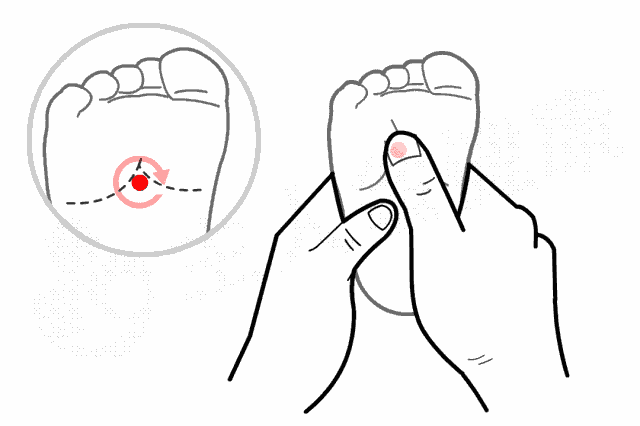 Location:Located at the bottom of the foot, in the depression at the front of the foot when curled, approximately at the intersection of the front 1/3 and back 2/3 of the line connecting the heads of the 2nd and 3rd metatarsal bones with the heel.Effects:The Yongquan point is one of the commonly used acupoints of the Kidney Meridian, primarily treating lung-related diseases:Constipation, urinary difficulties, and rebellious qi.05Pound the Xiaotianxin (Little Heavenly Heart)
Location:Located at the bottom of the foot, in the depression at the front of the foot when curled, approximately at the intersection of the front 1/3 and back 2/3 of the line connecting the heads of the 2nd and 3rd metatarsal bones with the heel.Effects:The Yongquan point is one of the commonly used acupoints of the Kidney Meridian, primarily treating lung-related diseases:Constipation, urinary difficulties, and rebellious qi.05Pound the Xiaotianxin (Little Heavenly Heart)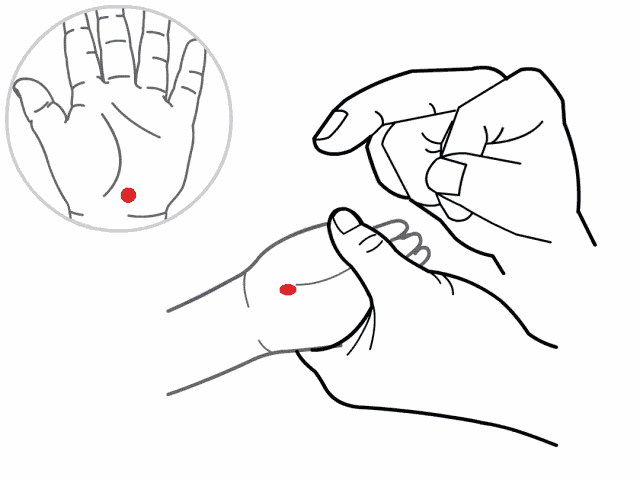 Location:In the depression at the junction of the major and minor thenar on the palm.Function:Opens all meridians, clears heart fire, induces sweating to expel pathogens, calms the mind, stops fright, and promotes sleep.Method:Clockwise kneading for 3-10 minutes.06Calm the Liver and Clear the Lungs
Location:In the depression at the junction of the major and minor thenar on the palm.Function:Opens all meridians, clears heart fire, induces sweating to expel pathogens, calms the mind, stops fright, and promotes sleep.Method:Clockwise kneading for 3-10 minutes.06Calm the Liver and Clear the Lungs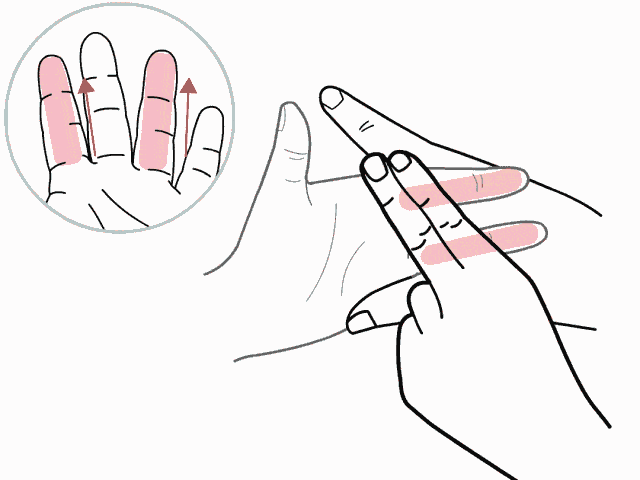 Function:Used for respiratory external pathogens.Method:Use the pads of the index and middle fingers to push along the pads of the child’s left index and ring fingers from the base of the fingers to the tips.07Clockwise Abdominal Massage
Function:Used for respiratory external pathogens.Method:Use the pads of the index and middle fingers to push along the pads of the child’s left index and ring fingers from the base of the fingers to the tips.07Clockwise Abdominal Massage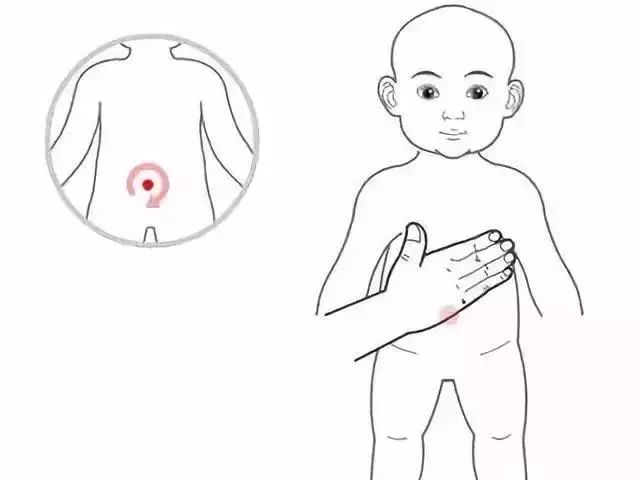 Function:Constipation, food stagnation, internal heat.08Grasp Fengchi (Wind Pool)
Function:Constipation, food stagnation, internal heat.08Grasp Fengchi (Wind Pool)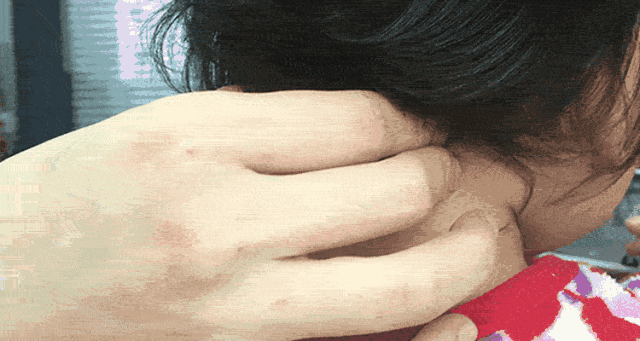 Function:Induces sweating for colds, relieves headaches, and reduces fever.09Reduce the Six Fu Organs
Function:Induces sweating for colds, relieves headaches, and reduces fever.09Reduce the Six Fu Organs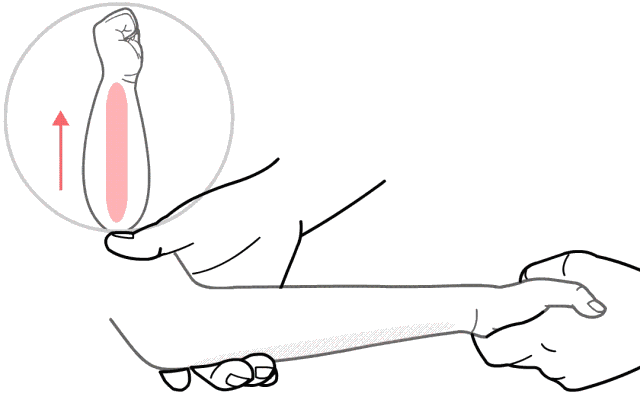 Location:On the ulnar side of the forearm, in a straight line from the elbow crease to the wrist crease.Function:Cools the blood, stops bleeding, detoxifies, reduces fever caused by excess heat, reduces inflammation, and eliminates phlegm heat.Method:Centrifugal push 100-300 times.Precautions:This point is cold in nature; avoid using it for those with deficiency-cold conditions.10Pinch Dazhui (Great Vertebra)
Location:On the ulnar side of the forearm, in a straight line from the elbow crease to the wrist crease.Function:Cools the blood, stops bleeding, detoxifies, reduces fever caused by excess heat, reduces inflammation, and eliminates phlegm heat.Method:Centrifugal push 100-300 times.Precautions:This point is cold in nature; avoid using it for those with deficiency-cold conditions.10Pinch Dazhui (Great Vertebra) Function:Used for colds and fevers.11Separate Yin and Yang of the Hands
Function:Used for colds and fevers.11Separate Yin and Yang of the Hands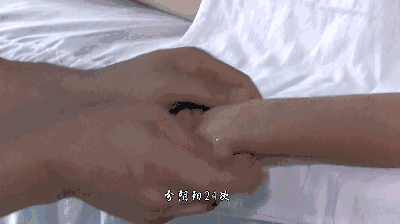 Location:At the base of the palm, starting from the Xiaotianxin point and pushing outward to separate the Yin and Yang points. Pushing towards the thumb side is the Yang point, and pushing towards the little finger side is the Yin point.Function:Balances Yin and Yang, eliminates food stagnation, transforms phlegm, and aids digestion.Pushing the Yang point is suitable for those with internal “cold excess”; pushing the Yin point is suitable for those with internal “heat excess”.Method:Separate Yin and Yang by using the pads of both thumbs to push outward from the Xiaotianxin point for 2-5 minutes.① Pushing the Yang point:Start from the Xiaotianxin point and push towards the major thenar for 2-5 minutes.② Pushing the Yin point:Start from the Xiaotianxin point and push towards the minor thenar for 2-5 minutes.12Clear the Large Intestine
Location:At the base of the palm, starting from the Xiaotianxin point and pushing outward to separate the Yin and Yang points. Pushing towards the thumb side is the Yang point, and pushing towards the little finger side is the Yin point.Function:Balances Yin and Yang, eliminates food stagnation, transforms phlegm, and aids digestion.Pushing the Yang point is suitable for those with internal “cold excess”; pushing the Yin point is suitable for those with internal “heat excess”.Method:Separate Yin and Yang by using the pads of both thumbs to push outward from the Xiaotianxin point for 2-5 minutes.① Pushing the Yang point:Start from the Xiaotianxin point and push towards the major thenar for 2-5 minutes.② Pushing the Yin point:Start from the Xiaotianxin point and push towards the minor thenar for 2-5 minutes.12Clear the Large Intestine Location:On the radial side of the index finger, in a straight line from the tip of the index finger to the space between the thumb and index finger.Function:Stops diarrhea, clears heat from the large intestine.Method:Back and forth push (clearing method) for 3-15 minutes, used for some intestinal heat, but not very obvious; centrifugal push (depleting method) for 3-15 minutes, used for very obvious intestinal heat.13Pinch the Four Seams Point
Location:On the radial side of the index finger, in a straight line from the tip of the index finger to the space between the thumb and index finger.Function:Stops diarrhea, clears heat from the large intestine.Method:Back and forth push (clearing method) for 3-15 minutes, used for some intestinal heat, but not very obvious; centrifugal push (depleting method) for 3-15 minutes, used for very obvious intestinal heat.13Pinch the Four Seams Point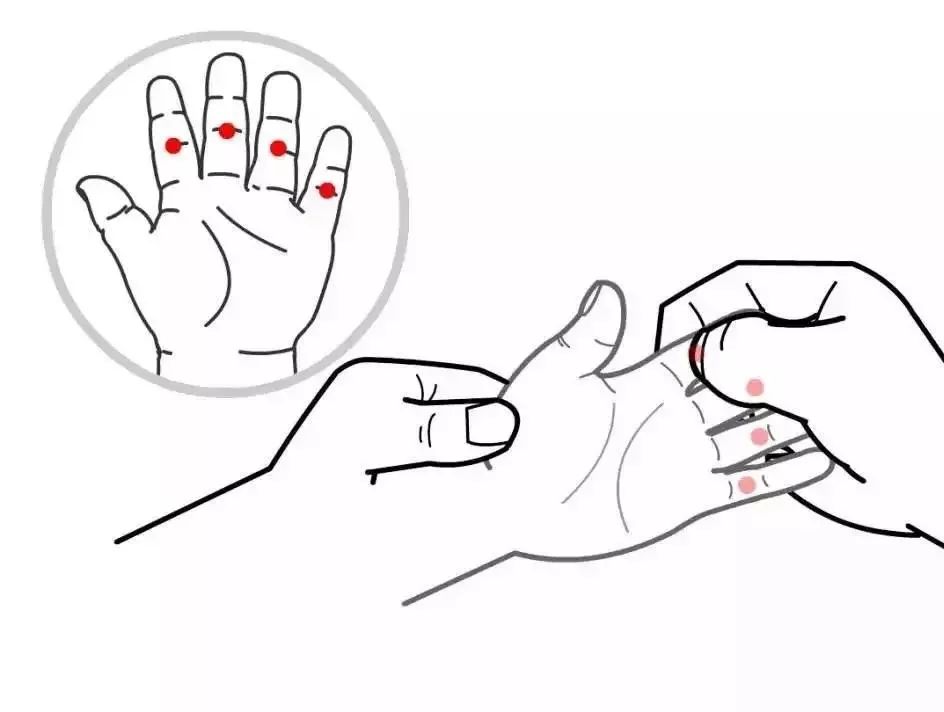 Function:Used for anorexia and food stagnation.14Knead the Lung Shu Point
Function:Used for anorexia and food stagnation.14Knead the Lung Shu Point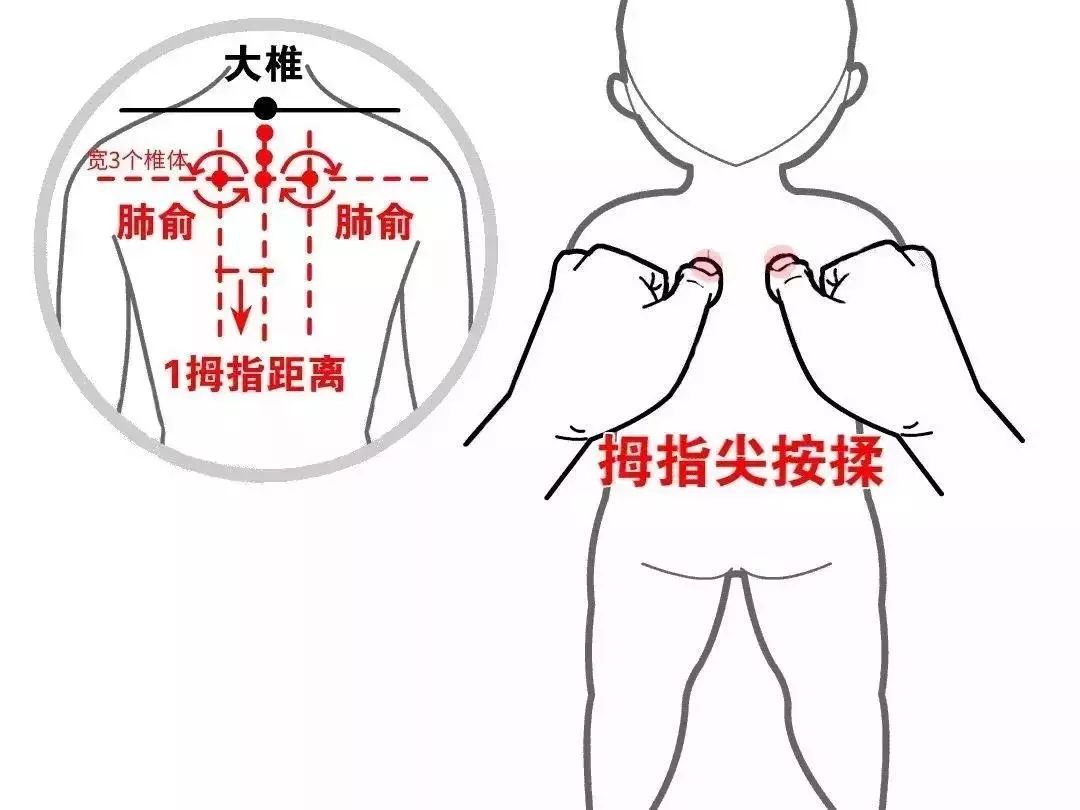 Function:Can be used for pneumonia and cough.15Push the Seven Vertebrae Downward
Function:Can be used for pneumonia and cough.15Push the Seven Vertebrae Downward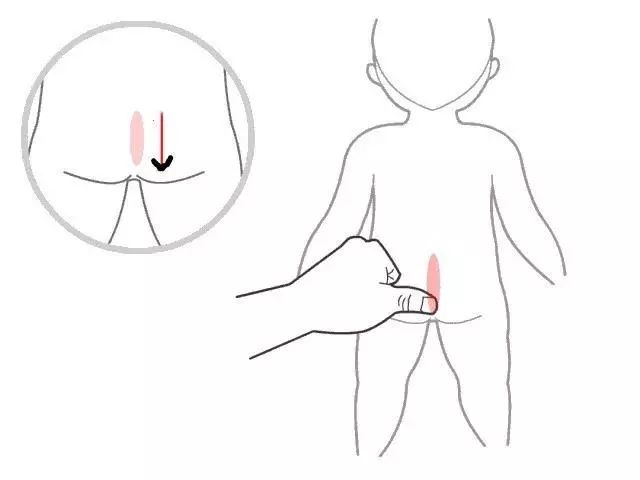 Function:Used for constipation and food stagnation.16Grasp Jianjing (Shoulder Well)
Function:Used for constipation and food stagnation.16Grasp Jianjing (Shoulder Well)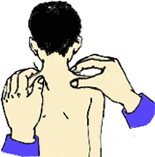 Function:Used for colds and convulsions.17Separate Abdominal Yin and Yang
Function:Used for colds and convulsions.17Separate Abdominal Yin and Yang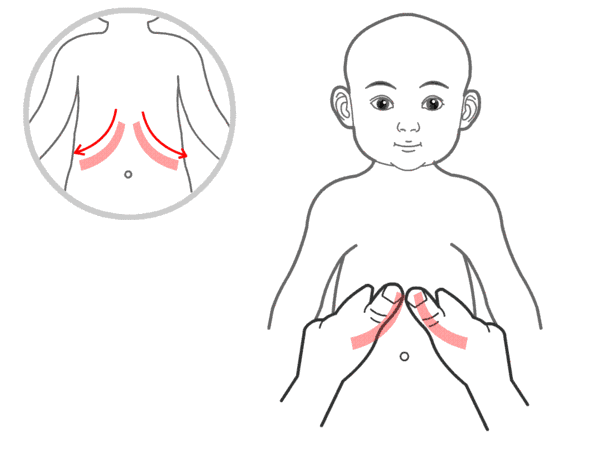 Function:Used for diarrhea, food stagnation, and constipation in the digestive system.18Horizontal Rubbing of the Small Transverse Lines
Function:Used for diarrhea, food stagnation, and constipation in the digestive system.18Horizontal Rubbing of the Small Transverse Lines Location:At the small transverse lines on the palm at the transverse joints of the index, middle, ring, and little fingers.Massage Methods:1. Pinch and Knead:Use the thumb nail to pinch and knead each point (can pinch once, knead three times), called pinching and kneading the small transverse lines.2. Pushing:Use the thumb to push up and down each point longitudinally, or have the child bring the four fingers together and push horizontally back and forth, called pushing the small transverse lines.Function:Opens the chest, disperses stagnation, and transforms phlegm. Mainly used for heat accumulation in the spleen and stomach, reducing fever, relieving bloating, dispersing masses, treating mouth sores, lip fissures, and irritability.19Knead the Banmen (Door of the Stomach)
Location:At the small transverse lines on the palm at the transverse joints of the index, middle, ring, and little fingers.Massage Methods:1. Pinch and Knead:Use the thumb nail to pinch and knead each point (can pinch once, knead three times), called pinching and kneading the small transverse lines.2. Pushing:Use the thumb to push up and down each point longitudinally, or have the child bring the four fingers together and push horizontally back and forth, called pushing the small transverse lines.Function:Opens the chest, disperses stagnation, and transforms phlegm. Mainly used for heat accumulation in the spleen and stomach, reducing fever, relieving bloating, dispersing masses, treating mouth sores, lip fissures, and irritability.19Knead the Banmen (Door of the Stomach)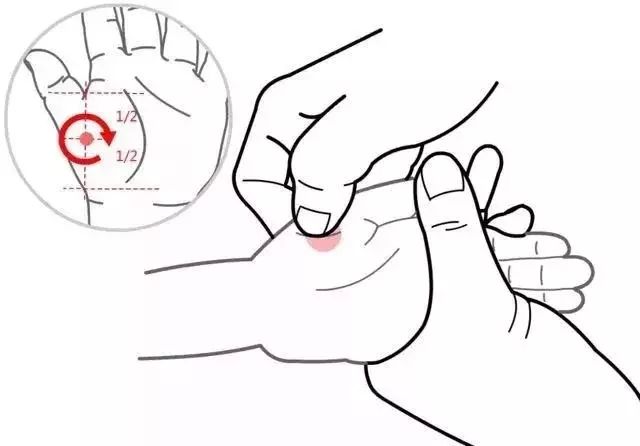 Function:Banmen is the door of the spleen and stomach, can open the Sanjiao, clear both deficiency heat and excess heat, and treat vomiting and diarrhea, and abdominal pain.20Knead Zusanli (Three Miles)
Function:Banmen is the door of the spleen and stomach, can open the Sanjiao, clear both deficiency heat and excess heat, and treat vomiting and diarrhea, and abdominal pain.20Knead Zusanli (Three Miles) Location:On the outer side of the lower leg, 3 inches below the knee, on the line connecting the knee and the ankle.Function:Dries dampness from the spleen, generates stomach qi.21Clear Tianhe Water (Heavenly River Water)
Location:On the outer side of the lower leg, 3 inches below the knee, on the line connecting the knee and the ankle.Function:Dries dampness from the spleen, generates stomach qi.21Clear Tianhe Water (Heavenly River Water)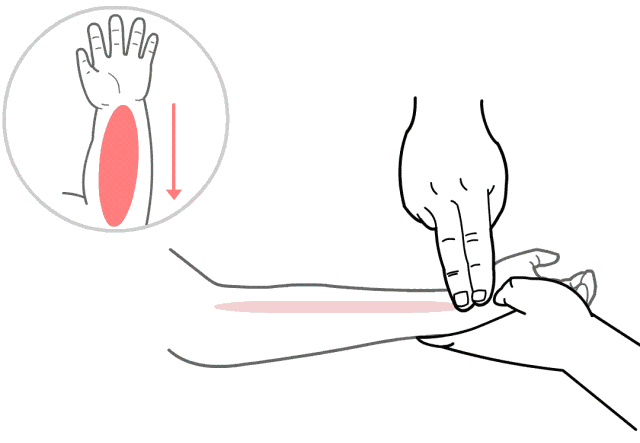 Location:On the palm side of the forearm, in a straight line from the midpoint of the wrist crease to the midpoint of the elbow crease.Function:Drains heart fire, calms the mind, relieves irritability, promotes urination, transforms phlegm heat, and reduces fever caused by heart fire. This point is cold in nature; avoid using it for those with deficiency-cold conditions.Method:Pushing towards the heart from the wrist crease to the elbow crease for 1-10 minutes.Inapplicable Situations:① Skin burns, scalds, abrasions, cracks, or scabies in the area should not be massaged.② Certain acute infectious diseases, such as cellulitis, bone tuberculosis, osteomyelitis, erysipelas, etc., should not be massaged.③ Various malignant tumors, trauma, fractures, and dislocations should not be massaged.④ Certain acute infectious diseases, such as acute hepatitis and pulmonary tuberculosis, should not be massaged.⑤ Severe heart disease, liver disease patients, and psychiatric patients should be cautious with massage.
Location:On the palm side of the forearm, in a straight line from the midpoint of the wrist crease to the midpoint of the elbow crease.Function:Drains heart fire, calms the mind, relieves irritability, promotes urination, transforms phlegm heat, and reduces fever caused by heart fire. This point is cold in nature; avoid using it for those with deficiency-cold conditions.Method:Pushing towards the heart from the wrist crease to the elbow crease for 1-10 minutes.Inapplicable Situations:① Skin burns, scalds, abrasions, cracks, or scabies in the area should not be massaged.② Certain acute infectious diseases, such as cellulitis, bone tuberculosis, osteomyelitis, erysipelas, etc., should not be massaged.③ Various malignant tumors, trauma, fractures, and dislocations should not be massaged.④ Certain acute infectious diseases, such as acute hepatitis and pulmonary tuberculosis, should not be massaged.⑤ Severe heart disease, liver disease patients, and psychiatric patients should be cautious with massage. Attention to Technique:Pediatric tuina must be clinically applied with appropriate pressure, paying attention to four aspects:1. The strength of tuina techniques varies; 2. Different children have varying tolerances to techniques; 3. Different diseases require different techniques; 4. As treatment progresses and conditions change, even for the same child, the pressure applied should vary. This ensures that the techniques are appropriately applied without excess.
Attention to Technique:Pediatric tuina must be clinically applied with appropriate pressure, paying attention to four aspects:1. The strength of tuina techniques varies; 2. Different children have varying tolerances to techniques; 3. Different diseases require different techniques; 4. As treatment progresses and conditions change, even for the same child, the pressure applied should vary. This ensures that the techniques are appropriately applied without excess.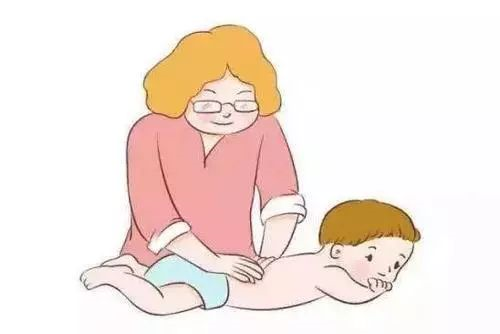 The above tuina methods are suitable for daily health care. If the baby is sick, do not perform tuina on your own; be sure to take the baby to seek medical treatment promptly.
The above tuina methods are suitable for daily health care. If the baby is sick, do not perform tuina on your own; be sure to take the baby to seek medical treatment promptly.
Learn maternal and infant care knowledge
Long press the QR code to follow↑↑
 Previous Highlights Review
Previous Highlights Review
-
Compared to children raised on formula, breastfed babies have three advantages that become more apparent as they grow.
-
Invisible poisons in the home can make children dull! The details that harm children’s health are often overlooked by parents!
- Is feeding milk during night crying necessary? Should night feedings be stopped? The 16 situations of night crying you must have encountered.
- Pediatricians: 90% of children’s colds are not caused by getting cold! This is the truth about children’s colds!
- Things to pay attention to in the first year after a baby is born!
- In one minute, learn to understand your baby’s frequent farting, which may be a “cry for help” signal!
- The intelligence development checklist for babies aged 0-3 years: Is your baby meeting the standards?
- If your child rolls around restlessly while sleeping, it is likely due to these reasons, which have nothing to do with calcium deficiency!
- Breastfeeding mothers should keep this “forbidden food list” handy!
- Overfeeding can damage the spleen and stomach! Pediatricians say: If your child shows these three signs, stop feeding!
- To keep children calm, three parts hunger and cold are essential for every parent to know!
- Children who often sleep with these three types of people will grow up to be excellent; it is a blessing for the child.
- These 20 foods can cause milk to return; breastfeeding mothers must avoid them!
- If you don’t regulate cold in the uterus before pregnancy, you may give birth to such a child!
- A mother accidentally killed her own twins; you will sympathize with this mother more when you know the truth.
- Four small actions of babies while sleeping are “health signals”; parents should understand and respond early.
- When will babies start to smile? Babies who smile early are smarter?
- For babies with food stagnation, internal heat, and restless sleep, this soup is very effective.
- Touching these three parts of the baby before sleep helps them sleep soundly and become smarter; many parents have never touched them.
- What factors affect breast milk supply? It is not breast size or weight, but these factors!
- Mothers should persist in breastfeeding until this age; babies will be very grateful when they grow up!
- Children with severe zinc deficiency frequently show these four “minor issues”; parents must pay attention!
- Frequent night feedings affect baby development; how to stop night feedings?
- Babies who do not sleep well may be due to mistakes made from the start!
- This action of mixing formula can harm the baby; formula should never be fed this way!
- The growth and development checklist for babies aged 1-12 months: Is your baby meeting the standards?
- How much milk should babies drink daily at each age? Check to see if your baby meets the standards!
- What is the best age to wean a baby? How to wean? Don’t wean after this time!
- A 3-year-old girl with food stagnation developed “malnutrition”; pediatric directors say: Parents without common sense truly harm their children.
- To increase milk supply during breastfeeding, remember this mantra!
- [Animated] Promoting growth and better sleep! Infant massage techniques for babies aged 0-3 years, hands-on teaching!
- Mom, please do not feed me at these six times.
- The “deadly bowl” has caused another toddler to develop leukemia! Your child may also be using this type of tableware.
- Three types of food that harm the spleen and stomach; if children eat them once, they may not digest for a week; parents are advised to give them less.
- New mothers’ first lesson: Why do newborns have bruises on their bottoms?
- A 6-month-old baby was poisoned by rice cereal, just because the adult added something to it!
- The weight of a baby at birth determines their intelligence? If it approaches this number, parents can be secretly happy!
- Do breastfed babies need water?!
- Invisible poisons in the home can make children dull! The details that harm children’s health are often overlooked by parents!
- It is not recommended to give babies these types of meat before the age of three! They are expensive and harmful to children, and can damage kidney development…..
- To raise a child who gets sick less often, these seven methods are essential for mothers and caregivers to know!
- Understanding the difference between withholding milk and returning milk.
- Late bedtimes have many disadvantages; not growing tall is secondary; the most serious issue is….
- The complete guide to early education for babies aged 0-12 months! Teaching babies this way will make employers very grateful!
- The reference standard for milk intake for babies aged 0-24 months: How much milk should babies eat daily? Understand it all in one article!
- 100 recipes for complementary foods for babies aged 6-24 months, worth saving!
- If you want to exclusively breastfeed, every mother should do this; have you done it?
- 15 methods to make babies laugh!
- Is your baby getting sick because they are overdressed? The best “dressing formula” for babies is here | Knowledge.
- A complete guide to fine motor skills training for babies aged 0-12 months; the more they practice, the smarter they become!
- There are several places on a baby’s body that are most sensitive to cold; every mother must know this!
- Six common mistakes in nighttime feeding for babies.
- Detailed training for babies aged 1-36 months at each stage of development; parents should save this to practice with their babies.
- Night feedings harm both mothers and babies; remember this best time to stop night feedings!
- These 20 foods can cause milk to return; breastfeeding mothers must avoid them!
- How to quickly increase milk supply after childbirth?
- A 1-year-old baby with kidney stones; doctors say: Parents are too confused; these complementary foods should not be eaten randomly.
- If you don’t regulate cold in the uterus before pregnancy, you may give birth to such a child!
- After birth, a baby experiences jaundice in the first month, colic in the second month, head lifting in the third month, rolling over in the fourth month, and teething in the fifth month….Babies who defecate at this “time point” daily indicate that their spleen and stomach are in good condition.During a child’s cough, these eight types of food should be avoided; don’t doubt it!This part should be touched by mothers 3 to 4 times a day; it helps the baby’s brain develop quickly, increases intelligence, and relieves constipation.“I personally harmed my child”; another child has left us; parents should not ignore this!The breastfeeding methods for babies change every month in the first ten months after birth.How many misunderstandings do you have about babies going barefoot?If there are no reactions after the month, it indicates that you have not left any postpartum issues.Regularly massaging these four areas makes babies more comfortable and smarter!13 quick and effective methods to reduce fever; mothers should save these!A comprehensive list of foods that should not be eaten during breastfeeding; be careful not to eat anything that can cause milk to return!!!
Some images are sourced from the internet, and the copyright belongs to the original authors.This WeChat public account is dedicated to maternal and infant knowledge popularization, with no commercial purpose. If there are any text, image, or video design infringements or violations, please inform us promptly for deletion.

